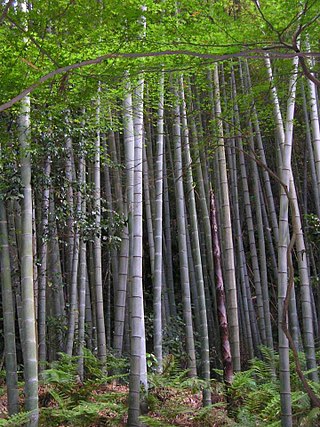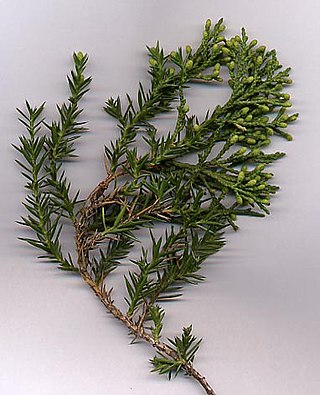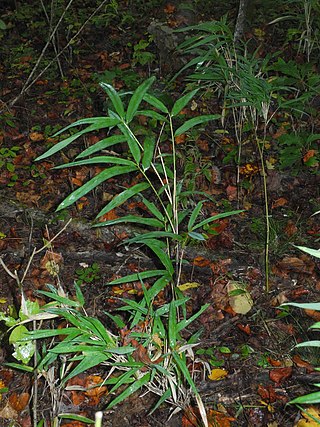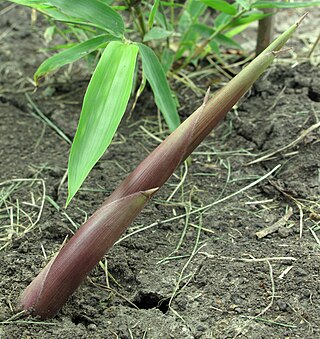
Bamboos are a diverse group of mostly evergreen perennial flowering plants making up the subfamily Bambusoideae of the grass family Poaceae. Giant bamboos are the largest members of the grass family, in the case of Dendrocalamus sinicus having individual stalks (culms) reaching a length of 46 meters (151 ft), up to 36 centimeters (14 in) in thickness and a weight of up to 450 kilograms (1,000 lb). The internodes of bamboos can also be of great length. Kinabaluchloa wrayi has internodes up to 2.5 meters (8 ft) in length. and Arthrostylidium schomburgkii has internodes up to 5 meters (16 ft) in length, exceeded in length only by papyrus. By contrast, the stalks of the tiny bamboo Raddiella vanessiae of the savannas of French Guiana measure only 10–20 millimeters (0.4–0.8 in) in length by about 2 millimeters (0.08 in) in width. The origin of the word "bamboo" is uncertain, but it probably comes from the Dutch or Portuguese language, which originally borrowed it from Malay or Kannada.

Phyllostachys is a genus of Asian bamboo in the grass family. Many of the species are found in central and southern China, with a few species in northern Indochina and in the Himalayas. Some of the species have become naturalized in parts of Asia, South America, Australia, and southern Europe.

Chamaecyparis obtusa is a species of cypress native to central Japan in East Asia, and widely cultivated in the temperate northern hemisphere for its high-quality timber and ornamental qualities, with many cultivars commercially available.

Juniperus chinensis, the Chinese juniper, is a species of plant in the cypress family Cupressaceae, native to China, Myanmar, Japan, Korea and the Russian Far East. Growing 1–20 metres tall, it is a very variable coniferous evergreen tree or shrub.

Chamaecyparis pisifera is a species of false cypress, native to central and southern Japan, on the islands of Honshū and Kyūshū.

Phyllostachys nigra, commonly known as black bamboo or purple bamboo, is a species of bamboo, native to Hunan Province of China, and is widely cultivated elsewhere.

Phyllostachys aureosulcata, the yellow groove bamboo, is a species of bamboo native to the Zhejiang Province of China. It is a running bamboo with a distinctive yellow stripe in the culm groove that is often grown as an ornamental.

Chrysalidocarpus lutescens, also known by its synonym Dypsis lutescens and as golden cane palm, areca palm, yellow palm, butterfly palm, or bamboo palm, is a species of flowering plant in the family Arecaceae, native to Madagascar and naturalized in the Andaman Islands, Thailand, Vietnam, Réunion, El Salvador, Cuba, Puerto Rico, the Canary Islands, southern Florida, Haiti, the Dominican Republic, Jamaica, the Leeward Islands and the Leeward Antilles. Its native names are rehazo and lafahazo.

Bambusa vulgaris, common bamboo, is an open-clump type bamboo species. It is native to Bangladesh, India, Sri Lanka, Southeast Asia, and to the province of Yunnan in southern China, but it has been widely cultivated in many other places and has become naturalized in several regions. Among bamboo species, it is one of the largest and most easily recognized.

Schizostachyum glaucifolium, common name Polynesian ʻohe, is a species of bamboo.

Arundinaria appalachiana, commonly known as hill cane, is a woody bamboo native to the Appalachian Mountains in the southeastern United States. The plant was elevated to the species level in 2006 based on new morphological and genetic information and was previously treated as a variety of Arundinaria tecta. The shortest member of its genus, hill cane ranges from 0.4–1.8 metres tall with a habit ranging from diffuse to pluri-caespitose. It is one of only three temperate species of bamboo native to North America. Hill cane is common on dry to mesic sites on upland slopes, bluffs and ridges in oak-hickory forests, which distinguishes it from other species in the genus: Arundinaria gigantea typically appears along perennial streams, while Arundinaria tecta is found in swamps and other very wet areas.

Phyllostachys rubromarginata, the reddish bamboo or red margin bamboo, is a species of Phyllostachys bamboo, native to Central China, specifically Guangxi and Guizhou.

Phyllostachys parvifolia is a running bamboo with thick culms that grow tall for a bamboo that endures cold weather.

Phyllostachys edulis, the mōsō bamboo, or tortoise-shell bamboo, or mao zhu, , is a temperate species of giant timber bamboo native to China and Taiwan and naturalised elsewhere, including Japan where it is widely distributed from south of Hokkaido to Kagoshima. The edulis part of the Latin name refers to its edible shoots. This bamboo can reach heights of up to 28 m (92 ft). This particular species of bamboo is the most common species used in the bamboo textile industry of China and other countries, for the production of rayon. Moso is less cold-hardy than many phyllostachys, surviving at a reduced height down to 5 degrees Fahrenheit (-15 °C).

Bloomeria crocea var. aurea, with the common name golden stars, is a variety of Bloomeria that is endemic to California. When blooming in late spring, its bright colors are distinctive.

Pseudosasa japonica, the arrow bamboo or metake, is a species of flowering plant in the grass family Poaceae, native to Japan and Korea. This vigorous bamboo forms thickets up to 6 m (20 ft) tall with shiny leaves up to 25 cm (9.8 in) long. The culms are typically yellow-brown and it has palm-like leaves. The common name "arrow bamboo" results from the Japanese Samurai using its hard and stiff canes for their arrows. It grows up to 4 cm (1.6 in) a day.

Fargesia murielae, the umbrella bamboo, is a species of flowering plant in the family Poaceae. It is a large, clump-forming evergreen bamboo, closely resembling Fargesia nitida in the same genus, but with yellow canes.

Phyllostachys bambusoides, commonly called madake, giant timber bamboo, or Japanese timber bamboo, is a species of flowering plant in the bamboo subfamily of the grass family Poaceae, native to China, and possibly also to Japan.

Dendrocalamus asper, also known as giant bamboo or dragon bamboo, is a giant, tropical, clumping species of bamboo native to Southeast Asia. In addition to its prolific nature across Asia, the plant's overall attractive appearance has seen this species introduced widely across South America and Africa, as well as Mexico and Florida. One advantage of this bamboo, especially for gardens, is its natural growth habit as a sympodial, colony-forming plant. Overall this bamboo maintains its own "personal" growing space, and does not grow laterally (runners), thus posing less risk of being environmentally-invasive.

Phyllostachys vivax, the Chinese timber bamboo, is a species of flowering plant in the bamboo subfamily of the grass family Poaceae, native to China.




















